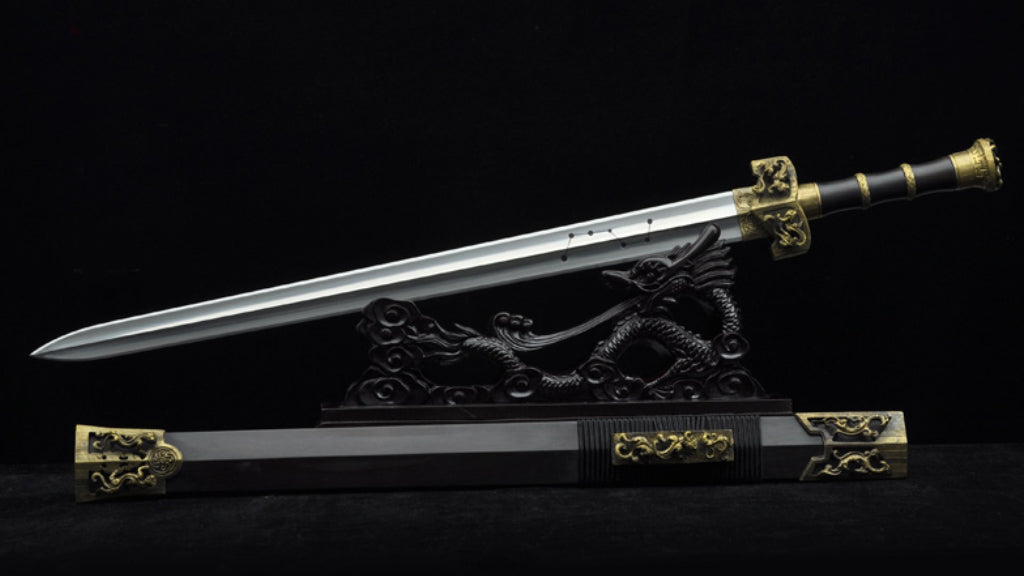The History of Longquan Sword

1. Longquan Sword in the Spring and Autumn Period and the Warring States Period
Sword making is best known in Wuyue area. The ancients said: "The sword of Wuyue (Yue) has moved to its place for good, because of the local atmosphere." Longquan produces copper and iron. Longquan sword, whose ancestor is the famous sword maker Ou Yezi, is the leader of iron swords.
2. Longquan Sword in Qin and Han Dynasties
Longquan's sword casting industry specializes in casting swords for the royal family.
3. Longquan Sword in Han Dynasty
The knives with a ring handle for chopping gradually replaced the sword. Longquan Sword has since faded out of the hustle and bustle of war, carrying the connotation of sword culture.
4. Longquan Sword in Wei and Jin Dynasties
The sword casting industry in Longquan was driven by the rapid population growth and the southward shift of the cultural center of gravity. The sword casting industry was relatively developed and had a certain scale.
5. Longquan Sword in Tang Dynasty
All famous swords must be called "Longquan", and Longquan has become synonymous with swords.
6. Longquan Sword of Song Dynasty
In the early years of Xianping, Yang Yi, a scholar of Hanlin and a history museum, said in "The Story of Jinsha Tower": "Longquan, the most humble town in the west of Jinyun, is the place where Europe smelts swords." In the third year of Jiading in the Southern Song Dynasty (1210), He Dan The "Longquan County Chronicle" contains: "There is Jianchi Lake in the vicinity. The lake, where the legendary Ou Yezi casts swords, his No. 1 Longyuan, is named after this town." The sword casting industry in Longquan Ancient City was very prosperous for a time, and there were many sword shops everywhere, which became another heyday after the Ouyezi era.
7. Longquan Sword in Yuan Dynasty
In October of the 17th year of Zhizheng (1358), Song Lian's "Longyuan Yishu Monument" stated: "Longyuan is the Longquan, which avoids the taboos of the Tang Dynasty and is named after the present. It is said that the place is where Ouyezi cast swords, and there is still a water name Jianxi Yan." Ming Wanli's "Qiao Canghui Ji Geography" records Longquan County, "Shannan is Qinxi, Jianchi Lake is in its shadow, and the surrounding area is dozens of acres. It is the place where Ouyezi cast his sword. Now it is an official field, and the well is still there, drinking its water in summer, and the cold current invades the teeth.” There is still a well in this ancient well, and there are General Ouyezi Temple and Sword Pavilion beside it. Because of their respect for Ou Yezi, swordsmiths of all dynasties went to Jianchi Lake to quench their swords every year during the Dragon Boat Festival. Each shop has two refined swords on the same day.
8. Longquan Sword of Qing Dynasty
In the late 19th century, guns replaced swords, and swords became martial arts instruments, Taoist instruments, stage props and ornamental crafts. Due to the shape and quality of Longquan swords, it is widely favored by martial arts enthusiasts and art connoisseurs. In the thirteenth year of Emperor Qianlong's reign in the Qing Dynasty (1748), blacksmith Zheng Yisheng opened a sword shop on the East Street of the town. The sword is not easy to rust, and the blade is sharp. During the Daoguang period of the Qing Dynasty (around 1830), Liao Taihe Jianpu in Longquan was famous for his engraving craftsmanship and inherited the decorative style of the Warring States Period. In the eighth year of Xianfeng in the Qing Dynasty (1858), the Taiping Army was stationed in Longquan for ten days and needed to replenish a large number of swords and weapons. In the early Guangxu period, Zhou Guohua, Zhou Guorong, and Zhou Guogui worshipped Zheng Wenxuan (the son of Zheng Sangu) of the Qianzihao Sword Shop. After completing his division, Zhou Guohua opened a 4D sword shop alone.
In 2014, Wudang Mountain discovered the seven-star Longquan sword of the Qing Dynasty, with the map of the Big Dipper inlaid on the sword. The sword is 1.26 meters long and weighs about 1.75 kilograms. The sword body and hilt are longer than ordinary swords. The wooden scabbard is large and the paint is bright. It is faintly visible, and there are cracks in the road. Although more than 200 years later, the blade is still sharp. The chisel flower is engraved with the four zodiac signs of Qinglong, White Tiger, Xuanwu and Suzaku, inlaid with the Big Dipper map, and the copper ornament is engraved with the Taoist pattern "Dark Eight Immortals".
9. Longquan Sword in the Late Qing Dynasty and Early Republic of China
During this period, the swordsmiths of Longquan made great efforts on the quality, packaging and cultural connotation of the sword, which further promoted the unique craftsmanship of Longquan sword, and was widely favored by martial arts enthusiasts and art connoisseurs. In the late Qing Dynasty and the early days of the Republic of China, there was a street along the north bank of the river in the county town, from Tianfei Palace to Guancang Alley, the jingle of sword shops connected to each other, day and night. In the autumn of the 19th year of the Republic of China, the National Martial Arts Museum held a martial arts competition in Nanjing. 30 Longquan swords were rated as the best swords, listed as prizes, and presented to the winners of martial arts performances. Longquan Sword is unique in the southeast and has a great reputation, and its products are sold throughout the country. It was the heyday of the sword making industry during the Republic of China. After the war of resistance against Japan began, merchants and provincial institutions from Shanghai, Hangzhou and other places moved to Longquan, and the cane sword became a must-have item for gentry officials.
After the founding of the People's Republic of China, the People's Government attached great importance to the restoration of the production and development of the Longquan sword, a traditional handicraft. Because the Longquan sword is famous all over the world, the country has included it as a national gift.
